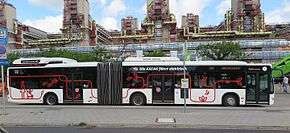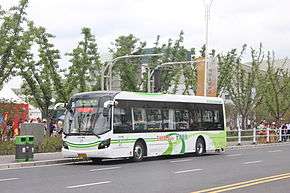Battery electric bus

A battery electric bus is a bus that is driven by an electric motor and obtains energy from an on-board battery. Many trolleybuses use batteries as an auxiliary or emergency power source.
Partial battery buses are equipped for charging with pantographs at bus stops and in the Depot.[1] Supercapacitors can be charged rapidly, reducing the time needed to prepare to resume operation.[2]
Advantages
Battery electric buses offer the zero-emission, quiet operation, better acceleration advantages of traditional buses powered by attachment to the grid via overhead lines. They also eliminate infrastructure needed for a constant grid connection and allow routes to be modified without infrastructure changes. They typically recover braking energy to increase efficiency by a regenerative brake. With energy consumption of about 1.2 kWh/km, the cost of ownership is lower than diesel buses.[3] In 2014 BYD eBus with an annual mileage of 70,000 kilometers (190 km / day) and was found to be cheaper than a comparable diesel bus. [4]
Disadvantages
As of 2016 battery buses have less range, higher weight, higher procurement costs. The reduced infrastructure for overhead lines if partially offset by the costs of the infrastructure to recharge the batteries. Battery buses are used almost exclusively in urban areas rather than for long-haul transport. Urban transit features relatively short intervals between charging opportunities. Sufficient recharging can take place within 4 to 5 minutes (250 to 450 kW) usually by induction or catenary.[3]
History


The first battery buses were mostly small, mini- or midi- buses. The improvement of battery technology from around 2010 led to the emergence of the battery bus, including heavier units such as twelve-meter standard buses and articulated wagons.
- In Shanghai catenary bus lines began switching to battery buses since 2009.[5]
- In 2011 bus manufacturer Contrac Cobus Industries from Wiesbaden announced the Cobus 2500e.
- In autumn 2012 Czech manufacturer Inmod supplied a LiFePo-powered SOR type EBN 8 to Mecklenburg-Vorpommern, Germany. The eight-meter-long vehicle has 22 seats, 35 standing places and a range of 160-170 kilometers a day, up to 220-260 km can be extended. The bus is recharged with a quick charger twice a day for one hour. Its maximum speed is 80 km/h.[6]
- Beginning in 2012 run the Wiener Linien on bus routes 2A and 3A used electric buses. They are charged to the end user via a pantograph, which is applied to short catenary pieces. These are fed by the tram catenary. The cars have a range of around 150 kilometers.[7]
- In May 2013 a battery bus began running between the airport and Palexpo in Geneva, Switzerland. This bus can be partially charged within 15 seconds. At the end of the line the charging process takes three to four minutes. The project cost five million francs.[8]
- The Regional Transport Ruhr-Lippe GmbH (RLG) (Germany) began operating an electric minibus as a Quartierbus in May 2013. Vehicle range is approximately 120 kilometers. Recharging takes about three hours when fully discharged. Recharging consumes over 1.5 hours during the lunch break.[9]
- The largest battery bus fleet is in Dalian, China. It includes 600 BYD buses. The purchase of a further 600 vehicles was planned for 2015.
- In 2013 battery buses entered service in the Netherlands.[10]
- In Germany in 2013 battery buses were undergoing tests in Bremen and in Bonn.[10]
- In 2015 BYD Auto planned to launch the first battery-double-decker bus.[11]
- In Braunschweig battery buses entered regular service at the end of 2013. The "Emil" (Electromobility means of inductive load) project uses inductive charging.[12][13] Both vehicles and charging stations were developed with Bombardier.[14]
- In Gumi, South Korea in 2013 a road section was adapted to allow inductive charging while driving. The technology was tobe tested with two electric buses.[15]
- In California, battery school buses since the end of October 2013 because of significantly lower operating costs, are used.[16]
- In Hamburg Rampini battery buses entered service in 2014 on line 48.[17][18]
- Dresdner Verkehrsbetriebe together with the Fraunhofer Institute for Transportation and Infrastructure Systems began testing battery buses in November 3, 2014.[19] On June 17, 2015 passenger service began on the first route in Saxony. A four-minute stop at the last stop provides sufficient charge, with a high-power charger to preheat the passenger compartment.[20]
- The Munich public transport company began testing battery buses in 2008. Experiments with Ebusco vehicles of were expected to reach a range of 300 km using lithium iron phosphate batteries.[21]
- In Pinneberg testing began in 2014.[22]
- In September 2015 four battery buses entered service in Berlin. The Solaris Urbino 12 charge by induction at the last stop.[23][24]
- In July 2015 the Schleswig-Holstein Rendsburg purchased a Sileo battery bus with a range of 200 km for 450,000 euros. The bus does not charge during operation and can be operated for half a day. The bus is charged from a rooftop photovoltaic system.[25]
- In Bonn test entered regular service in 2013. The range is at least 200 km.[26]
- Botosani, Romania planned for public transport to operate fully electrically. at a conversion cost of 20 million euros.[27]
.jpg)
- In October 2015 the double-decker buses were converted to BYD electrics with a range of 250 km. London's center-city access toll is waived for battery buses.[28][29]
- As of 2015, BYD had sold about 6,000 of its buses worldwide. [30] BYD is the world leader in the sale of electric vehicles.[31]
- The California Department of Transportation contracted with Antelope Valley Transit Authority (AVTA) to switch its buses to 85 BYD battery buses with a range of at least 160 miles. Models include a 40 foot low-floor transit bus, a 60-foot low-floor articulated and a 45 foot commuter bus. Savings were expected to be $ 46,000 (41,300 euros) per bus per year.[32][33]
See also
| Wikimedia Commons has media related to Battery-powered buses. |
References
- ↑ Trolley:Motion, 27. Mai 2013: Shanghai - Weitere Reduzierung des Trolleybusnetzes - ungewisse Zukunft Archived December 3, 2013, at the Wayback Machine., aufgerufen 8. Oktober 2013
- ↑ MIT-Technology Review: Next Stop: Ultracapacitor Buses, aufgerufen 18. November 2013
- 1 2 Fraunhofer-Institut für Verkehrs- und Infrastruktursysteme Praxistest mit einem Fahrzeug zwischen 03.11.2014 bis zum 30.01.2015
- ↑ BYD erhält Rekordbestellung über 2000 eBusse und 1000 Elektroautos ChinaObserver vom 12. Mai 2014. Abgerufen am 15. Juli 2015.
- ↑ Shanghai: Investitionen im Netz bleiben aus, Meldung auf www.trolleymotion.ch vom 12. November 2012
- ↑ Der SOR-Elektrobus auf www.inmod.de Archived February 28, 2015, at the Wayback Machine.
- ↑ Elektrobusse ab 2013 in der City. auf wien.orf.at, abgerufen am 10. September 2012.
- ↑ DOSSIER DE PRESSE AVRIL 2013, TOSA (PDF; 543 kB)
- ↑ GmbH, Regionalverkehr Ruhr-Lippe. "Seite nicht gefunden". Archived from the original on 2016-03-14.
- 1 2 newstixs, 30. Juni 2013: Elektromobilität für Bonn: Positive Testergebnisse mit chinesischem Elektrobus, aufgerufen 16. Juli 2013
- ↑ BYD Internetauftritt des Herstellers. Abgerufen am 23. November 2014.
- ↑ Braunschweiger Verkehrs AG: Elektrobusse mit induktiver Ladetechnik – der Schritt in ein neues Zeitalter Archived August 20, 2014, at the Wayback Machine., aufgerufen 8. Oktober 2013
- ↑ YouTube: EmiL - Elektromobilität mittels induktiver Ladung, Videoanimation, aufgerufen 8. Oktober 2013
- ↑ eurailpress.de, 11. September 2013: Bombardier: Primove-Station in Braunschweig in Betrieb, aufgerufen 8. Oktober 2013
- ↑ Bild.de, 8. August 2013: Südkorea setzt Straßen unter Strom, aufgerufen 21. Oktober 2013
- ↑ EarthTechling, 4. November 2013: Electric School Bus Idea Set To Debut In California, aufgerufen 16. November 2013
- ↑ Münder, Peter (28 October 2014). "Elektromobilität: Die Bergziege summt jetzt" – via Die Zeit.
- ↑ "Aktuell – SAT.1 REGIONAL".
- ↑ Fraunhofer-Elektrobus wird auf Linie 61 getestet
- ↑ "OmnibusRevue - Erste E-Buslinie Sachsens nimmt Betrieb auf".
- ↑ muenchen.de. "SWM und MVG testen neuen Elektrobus".
- ↑ Neuer batteriebetriebener E-Bus fährt in Pinneberg, 12. Mai 2014
- ↑ Die BVG präsentiert ihre neuen Elektrobusse, 1. Juli 2015
- ↑ Video: Elektrische Buslinie in Berlin startet in die Testphase, 8. Juli 2015
- ↑ Umweltfreundlich, leise, aber noch nicht ausgereift, 7. Juli 2015
- ↑ Stadtwerke kaufen sechs Elektrobusse, 7. Juli 2015
- ↑ Elektromobilität in Rumänien: Gemeinde plant 100% elektrischen ÖPNV, 23. Juni 2015
- ↑ London kauft elektrische Busse aus China, 10. Juli 2015
- ↑ Londons Doppeldecker fahren bald elektrisch, 10. Juli 2015
- ↑ BYD anticipated sales of 6,000 electric buses worldwide in 2015 vom 6. Januar 2016. Abgerufen am 6. Januar 2016.
- ↑ China’s BYD is World’s Largest EV Manufacturer vom 28. Dezember 2015. Abgerufen am 6. Januar 2016.
- ↑ it-times.de, 12. Februar 2016: BYD: Großauftrag für Elektrobusse aus Kalifornien, aufgerufen 8. März 2016
- ↑ oekonews.at, 17. Februar 2016: Kalifornien: Die erste 100% elektrische Busflotte rollt demnächst, aufgerufen 8. März 2016